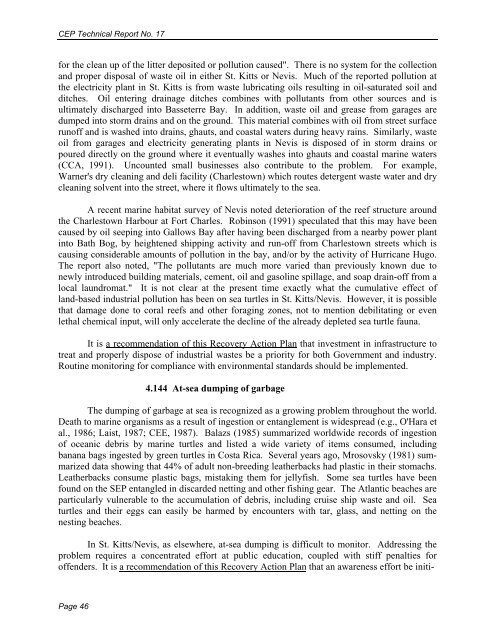Sea Turtle Recovery Action Plan for St. Kitts and Nevis - WIDECAST
Sea Turtle Recovery Action Plan for St. Kitts and Nevis - WIDECAST
Sea Turtle Recovery Action Plan for St. Kitts and Nevis - WIDECAST
Create successful ePaper yourself
Turn your PDF publications into a flip-book with our unique Google optimized e-Paper software.
CEP Technical Report No. 17<br />
<strong>for</strong> the clean up of the litter deposited or pollution caused". There is no system <strong>for</strong> the collection<br />
<strong>and</strong> proper disposal of waste oil in either <strong>St</strong>. <strong>Kitts</strong> or <strong>Nevis</strong>. Much of the reported pollution at<br />
the electricity plant in <strong>St</strong>. <strong>Kitts</strong> is from waste lubricating oils resulting in oil-saturated soil <strong>and</strong><br />
ditches. Oil entering drainage ditches combines with pollutants from other sources <strong>and</strong> is<br />
ultimately discharged into Basseterre Bay. In addition, waste oil <strong>and</strong> grease from garages are<br />
dumped into storm drains <strong>and</strong> on the ground. This material combines with oil from street surface<br />
runoff <strong>and</strong> is washed into drains, ghauts, <strong>and</strong> coastal waters during heavy rains. Similarly, waste<br />
oil from garages <strong>and</strong> electricity generating plants in <strong>Nevis</strong> is disposed of in storm drains or<br />
poured directly on the ground where it eventually washes into ghauts <strong>and</strong> coastal marine waters<br />
(CCA, 1991). Uncounted small businesses also contribute to the problem. For example,<br />
Warner's dry cleaning <strong>and</strong> deli facility (Charlestown) which routes detergent waste water <strong>and</strong> dry<br />
cleaning solvent into the street, where it flows ultimately to the sea.<br />
A recent marine habitat survey of <strong>Nevis</strong> noted deterioration of the reef structure around<br />
the Charlestown Harbour at Fort Charles. Robinson (1991) speculated that this may have been<br />
caused by oil seeping into Gallows Bay after having been discharged from a nearby power plant<br />
into Bath Bog, by heightened shipping activity <strong>and</strong> run-off from Charlestown streets which is<br />
causing considerable amounts of pollution in the bay, <strong>and</strong>/or by the activity of Hurricane Hugo.<br />
The report also noted, "The pollutants are much more varied than previously known due to<br />
newly introduced building materials, cement, oil <strong>and</strong> gasoline spillage, <strong>and</strong> soap drain-off from a<br />
local laundromat." It is not clear at the present time exactly what the cumulative effect of<br />
l<strong>and</strong>-based industrial pollution has been on sea turtles in <strong>St</strong>. <strong>Kitts</strong>/<strong>Nevis</strong>. However, it is possible<br />
that damage done to coral reefs <strong>and</strong> other <strong>for</strong>aging zones, not to mention debilitating or even<br />
lethal chemical input, will only accelerate the decline of the already depleted sea turtle fauna.<br />
It is a recommendation of this <strong>Recovery</strong> <strong>Action</strong> <strong>Plan</strong> that investment in infrastructure to<br />
treat <strong>and</strong> properly dispose of industrial wastes be a priority <strong>for</strong> both Government <strong>and</strong> industry.<br />
Routine monitoring <strong>for</strong> compliance with environmental st<strong>and</strong>ards should be implemented.<br />
4.144 At-sea dumping of garbage<br />
The dumping of garbage at sea is recognized as a growing problem throughout the world.<br />
Death to marine organisms as a result of ingestion or entanglement is widespread (e.g., O'Hara et<br />
al., 1986; Laist, 1987; CEE, 1987). Balazs (1985) summarized worldwide records of ingestion<br />
of oceanic debris by marine turtles <strong>and</strong> listed a wide variety of items consumed, including<br />
banana bags ingested by green turtles in Costa Rica. Several years ago, Mrosovsky (1981) summarized<br />
data showing that 44% of adult non-breeding leatherbacks had plastic in their stomachs.<br />
Leatherbacks consume plastic bags, mistaking them <strong>for</strong> jellyfish. Some sea turtles have been<br />
found on the SEP entangled in discarded netting <strong>and</strong> other fishing gear. The Atlantic beaches are<br />
particularly vulnerable to the accumulation of debris, including cruise ship waste <strong>and</strong> oil. <strong>Sea</strong><br />
turtles <strong>and</strong> their eggs can easily be harmed by encounters with tar, glass, <strong>and</strong> netting on the<br />
nesting beaches.<br />
In <strong>St</strong>. <strong>Kitts</strong>/<strong>Nevis</strong>, as elsewhere, at-sea dumping is difficult to monitor. Addressing the<br />
problem requires a concentrated ef<strong>for</strong>t at public education, coupled with stiff penalties <strong>for</strong><br />
offenders. It is a recommendation of this <strong>Recovery</strong> <strong>Action</strong> <strong>Plan</strong> that an awareness ef<strong>for</strong>t be initi-<br />
Page 46
















